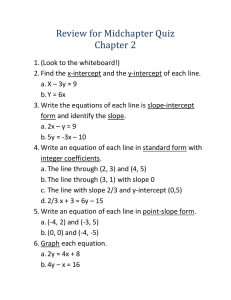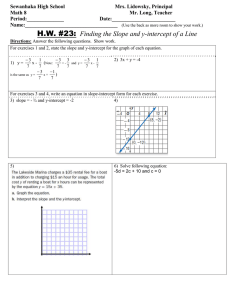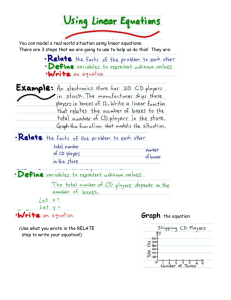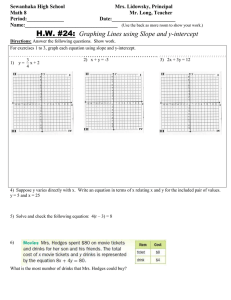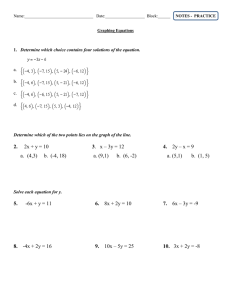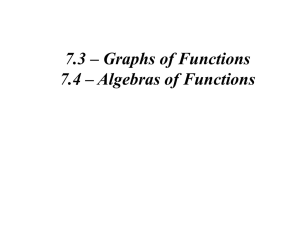1.3 F15 O’Brien CA 6 ed HLR
advertisement
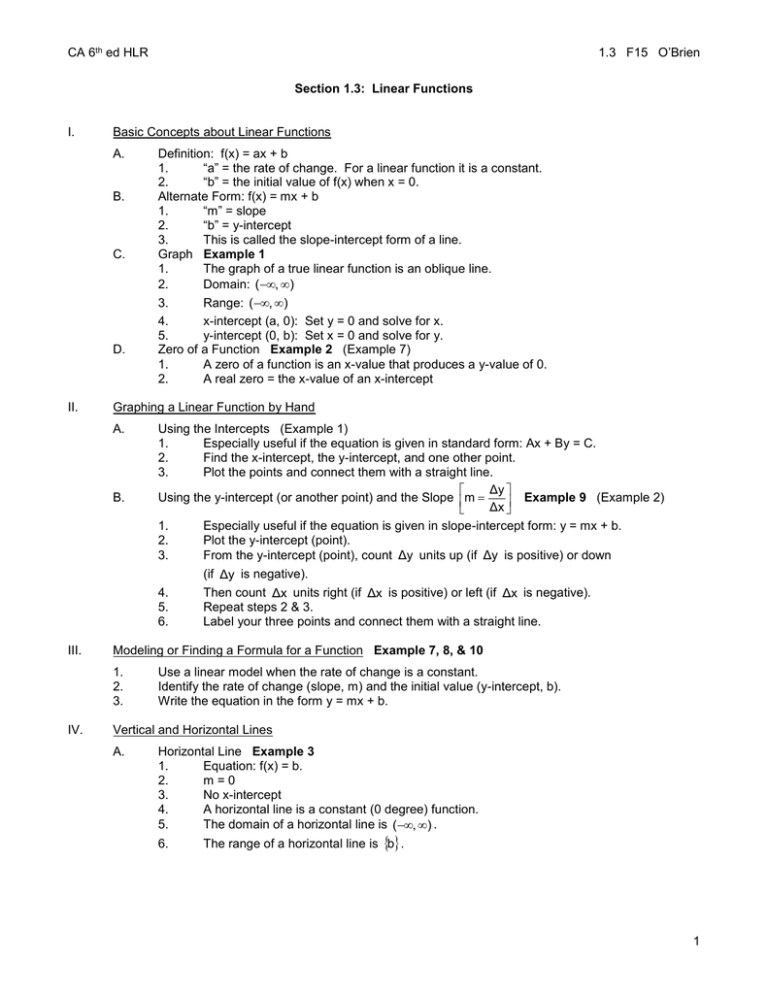
1.3 F15 O’Brien
CA 6th ed HLR
Section 1.3: Linear Functions
I.
Basic Concepts about Linear Functions
A.
B.
C.
D.
II.
Definition: f(x) = ax + b
1.
“a” = the rate of change. For a linear function it is a constant.
2.
“b” = the initial value of f(x) when x = 0.
Alternate Form: f(x) = mx + b
1.
“m” = slope
2.
“b” = y-intercept
3.
This is called the slope-intercept form of a line.
Graph Example 1
1.
The graph of a true linear function is an oblique line.
2.
Domain: (, )
3.
Range: (, )
4.
x-intercept (a, 0): Set y = 0 and solve for x.
5.
y-intercept (0, b): Set x = 0 and solve for y.
Zero of a Function Example 2 (Example 7)
1.
A zero of a function is an x-value that produces a y-value of 0.
2.
A real zero = the x-value of an x-intercept
Graphing a Linear Function by Hand
A.
B.
Using the Intercepts (Example 1)
1.
Especially useful if the equation is given in standard form: Ax + By = C.
2.
Find the x-intercept, the y-intercept, and one other point.
3.
Plot the points and connect them with a straight line.
Δy
Using the y-intercept (or another point) and the Slope m
Example 9 (Example 2)
Δx
1.
Especially useful if the equation is given in slope-intercept form: y = mx + b.
2.
Plot the y-intercept (point).
3.
From the y-intercept (point), count Δy units up (if Δy is positive) or down
4.
5.
6.
III.
Modeling or Finding a Formula for a Function Example 7, 8, & 10
1.
2.
3.
IV.
(if Δy is negative).
Then count Δx units right (if Δx is positive) or left (if Δx is negative).
Repeat steps 2 & 3.
Label your three points and connect them with a straight line.
Use a linear model when the rate of change is a constant.
Identify the rate of change (slope, m) and the initial value (y-intercept, b).
Write the equation in the form y = mx + b.
Vertical and Horizontal Lines
A.
Horizontal Line Example 3
1.
Equation: f(x) = b.
2.
m=0
3.
No x-intercept
4.
A horizontal line is a constant (0 degree) function.
5.
The domain of a horizontal line is (, ) .
6.
The range of a horizontal line is b .
1
1.3 F15 O’Brien
CA 6th ed HLR
B.
V.
Vertical Line Example 4
1.
Equation: x = a
2.
m is undefined
3.
No y-intercept
4.
A vertical line is not a function.
5.
The domain of a vertical line is {a}.
6.
The range of a vertical line is (, ) .
Slope of a Line and Average Rate of Change
A.
B.
C.
D.
E.
Δy (delta y) = y2 – y1 = the change in y = the rise
Δx (delta x) = x2 – x1 = the change in x = the run
y y1 Δy rise
Slope Formula: m 2
Examples 5 & 6 (Example 7)
x 2 x1 Δx run
Geometric Orientation Base on Slope
1.
If m > 0, the line rises from left to right.
2.
If m < 0, the line falls from left to right.
3.
If m = 0 (i.e. Δy =0), the line is horizontal.
4.
If m is undefined (i.e. Δx = 0), the line is vertical.
Interpreting Slope as Average Rate of Change (Example 6)
1.
The units for an average rate of change are unit of output (y) per unit input (x).
2.
Examples of units: miles per hour; millions of dollars per year; inches per day
2
CA 6th ed HLR
1.3 F15 O’Brien
3
CA 6th ed HLR
1.3 F15 O’Brien
4
